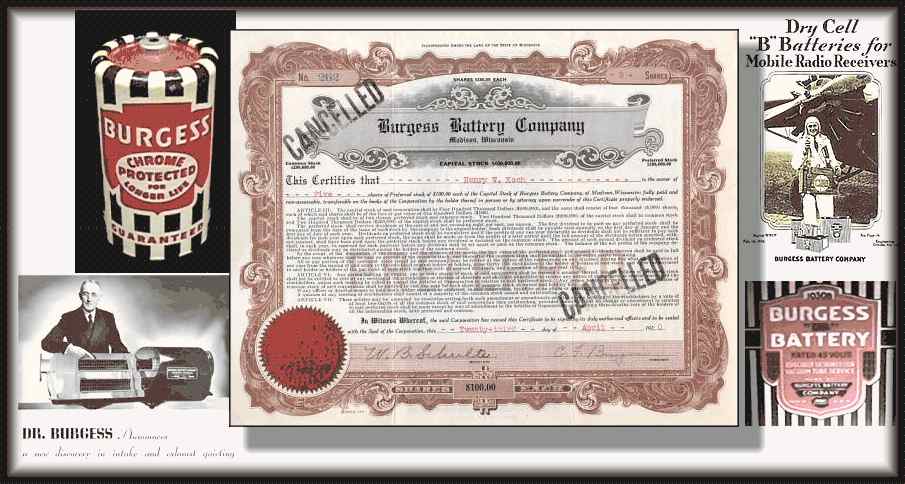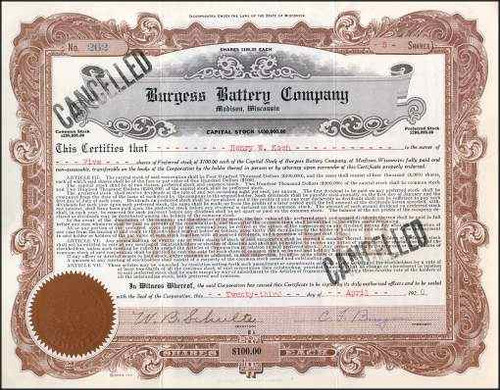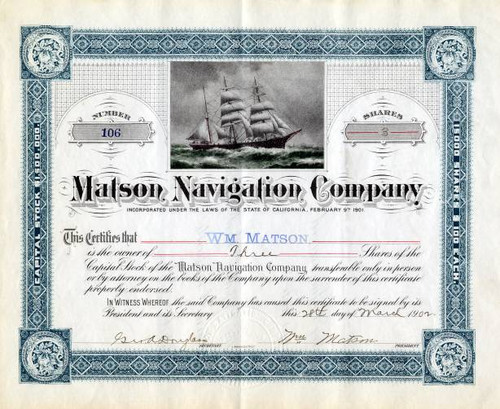Beautifully engraved scarce Certificate from the Burgess Battery Company issued in 1920. This historic document has an ornate border around it with the company's name in fancy print. This item is hand signed by its founder and president, Charles Frederick Burgess and is over 102 years old. Professionally reinforced.

Dr. Burgess was a prolific inventor with wide-ranging research interests that included the fields of electrical, acoustical, metallurgical, and aeronautical engineering. Among his innovative achievements from 1910 to 1945 were the development of the dry cell battery, the microswitch, and acoustical silencing devices. The following is a brief of the Burgess Battery Company: 1910 Dr. C. F. Burgess established Northern Chemical Engineering Laboratory in Madison, Wisconsin. 1920 The Burgess Battery Company is founded to commercially develop the dry cell technology. 1928 The Acoustical division of the Burgess Battery Company is formed to commercially market acoustical ceiling tiles developed by Burgess Laboratories. 1930 The silencing snubber principle is developed and is followed by the introduction of industrial silencers for application on engines, blowers, and vacuum pumps. The Burgess 'Straight Through' muffler is adopted and used by 13 automobile manufacturers. 1945 Pulsation Snubbers are introduced for use on reciprocating compressors for control of pulsation induced vibrations. C. F. Burgess was born in Oshkosh, Wisconsin on January 5, 1873. He graduated from the University of Wisconsin with an electrical engineering degree in 1895. He then took up a study of physical chemistry and electrochemistry while teaching. He became well known for his research on electrolytic iron and dry cells. He founded the Burgess battery Company and published many of his research and developments in the transactions of the Society. He and his organization were engaged in many technical developments: dry batteries, acoustical products, measuring instruments and methods for noise control, the utilization of wood wastes, development of new clay products, and building materials. Dr. Burgess was a prolific inventor with wide-ranging research interests that included the fields of electrical, acoustical, metallurgical, and aeronautical engineering. Among his innovative achievements from 1910 to 1945 were the development of the dry cell battery, the microswitch, and acoustical silencing devices. Burgess' career in the battery industry began at the turn of the century when the French Battery Company of Madison (renamed the Rayovac Company in the mid-1930s) asked him to analyze some of its products. Already operating Northern Chemical Engineering Laboratories, a consulting and experimental facility, Burgess knew he could help the start-up manufacturer produce a better electric dry battery. Soon he bought 100 shares of French stock, was elected to its board and took over the engineering department. After World War I broke out in 1914, the French received a military contract to produce one million 6-inch batteries for use in field telephones. That same year, batteries produced in Burgess' lab were assembled into jackets at the French plant to be sold under the name "Fleur-de-Lis." Burgess-produced flashlights called "French Flashers" also became popular around this time. These developments led to a doubling in sales for both flashlight and 6-inch batteries. A fire broke out in 1915 in the heart of production season, posing a serious setback for both French and Burgess, who by then had moved his cell-manufacturing operation to the French plant. The blaze destroyed the facility, and relationships were never the same after it was reconstructed. In 1916, Burgess parted ways with French Battery Company, authorizing the manufacturer to produce flashlights under the patents he then held. Burgess left the College of Engineering in 1913 after 19 years on the faculty, initially as an electrical engineering instructor before starting the chemical engineering program in 1905. The ties he formed during these years had a great impact on his business endeavors. For example, Research Products, another major Madison company, was spawned by the work of Burgess and his assistants. Walter Schulte, who also attended the University of Wisconsin, initially worked for Burgess at Northern Chemical Laboratories, and then followed him to the Burgess Battery Company, which Burgess founded in Madison in 1917. Schulte became one of the company's new directors, and fellow ChE alumnus. Benjamin Smith Reynolds became a manager. In 1925, Freeport, Ill., offered Burgess $50,000 to start a new division of his company there. Burgess did just that... but returned the money. That division was later renamed Microswitch, and today forms a division of Honeywell Inc.










